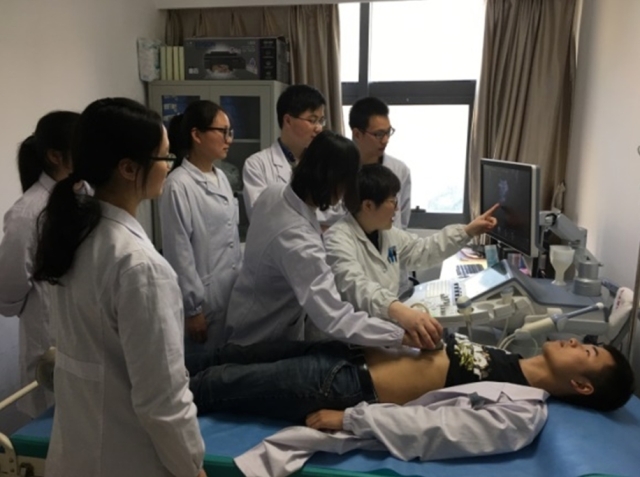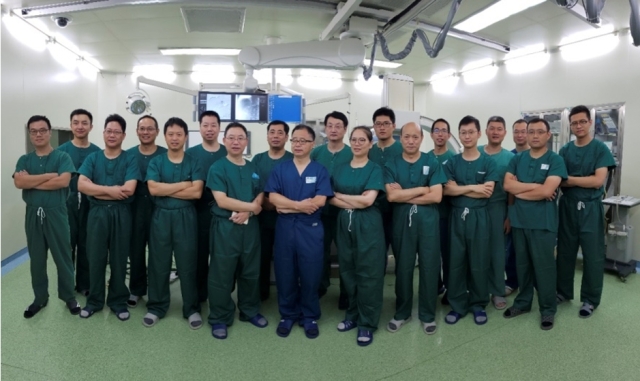Department of Medical Imaging
Welcome to the Department of Medical Imaging at Southeast University School of Medicine. Our Department not only provides the highest quality of patient care in imaging diagnosis and interventional therapy, but also leads the nation in biomedical imaging science research and medical education. We pride ourselves on our diverse and talented faculties, who are based at four divisions of Radiology, Ultrasound, Nuclear Medicine and interventional therapy of the Zhongda Hospital.
Division of Radiology
Introduction
The Division of Radiology, founded in 1935, is nationally known for its excellence. The division brings an elite group of clinicians, researchers and educators together. These faculty members have been founded over thirty millions RMB from nation in recent ten years and rewarded more than 20 provincial and ministerial level scientific research awards. Our Division has gained numerous “the first” and “the unique” of medical imaging in Jiangsu Province: the first batch of 135 medical key disciplines, the first batch of 11th Five-Year Plan of Jiangsu, the first molecular imaging key laboratory of Jiangsu and the only one national clinical key specialty in Jiangsu Province.
The Division is comprised of a Key Laboratory of Functional and Molecular Imaging of Jiangsu, which is an interdisciplinary research laboratory that provides state-of-the-art small animal MRI and other modalities imaging equipment, infrastructure, and expertise for the development and application of multiple imaging methodologies in biomedical research.
We offer master’s degrees and doctoral programs for both clinic and science of imaging medicine. Students here work in well-equipped hospital and laboratories, and establish close relationships with faculty mentors. We provide students the excellent medical imaging training and course involved in the English-speaking brand curriculum construction project of China for international students. Students can choose from a broad selection of courses at the Southeast University as well.
Major Research Directions
We offer three different biomedical science majors: molecular imaging, functional brain imaging and interventional therapy. The molecular imaging is to develop probes to image the particular targets or pathways, by which a pre-disease state that occur before typical symptoms of a disease can be detected or a precise diagnosis can be made noninvasively. The functional imaging provided a great technique to reveal how the brain with various psychopathologies works.

Division of Diagnostic Ultrasound
Introduction
Established in 1978, the Division of Diagnostic Ultrasound in Zhongda Hospital Southeast University is one of the first units in China to carry out the diagnosis and treatment of ultrasound (two-dimensional ultrasound, doppler ultrasound, interventional ultrasound, contrast-enhanced ultrasound). The department currently employs 21 ultrasound professionals with consummate skills. Over the past 40 years, our department has continuously updated ultrasonic diagnostic equipment, continuously increased the number of ultrasonic diagnostic personnel, and improved the diagnostic level. Now it has become an advanced department of ultrasonic diagnosis in Jiangsu province with comprehensive strength including medical treatment, teaching and scientific research.
Major Research Directions:
Research is focused on interventional ultrasound diagnosis and treatment, intracavitary ultrasonography, neonatal craniocerebral ultrasonography and ultrasonographic diagnosis of early/middle pregnancy. In many of these areas, the Department plays a leading role in the domestic ultrasound community. The research of the Department has consistently been given a high ranking in the Government’s assessments of research in Universities and was rated top in China.

Division of Nuclear Medicine
Introduction
The DIvision of Nuclear Medicine is an important component of the Medical Imaging Department, offering doctoral program of Medical Imaging and Nuclear Medicine. The Teaching and Research Section of Nuclear Medicine, Radioisotope Research Institute, and Nuclear Medicine Department of Zhongda Hospital constitute a trinity. As early as 1973, Professor Ding Depan, one of the main founders and leaders of nuclear medicine in China, founded the Teaching and Research Section of Radiation Health (Direction of Isotope). The master’s degree program was approved in the first batch by Ministry of Education and in 1984 and doctoral program in 2003. Under the leadership of well-known experts such as Zhang Zhilin, Wu Fuping, Liu Lu and Du Minghua, the Teaching and Research Section of Nuclear Medicine keeps developing and has become a comprehensive academic discipline with strong academic atmosphere, solid scientific research capability, and a reasonable talent recruitment through continuous efforts. There are 12 faculty members in our section, including 2 professors and 2 associate professors. In recent years, more than ten National 863 Programs, Programs of National Natural Science Foundation, and Provincial- and Ministerial-level Scientific Research Projects have been completed. Our section has been awarded several Provincial- and Ministerial-level Scientific and Technological Progress Awards. Each year, a number of academic papers are published in domestic and international authoritative journals. The Section has cultivated plenty of doctors and masters for this discipline.
2 Major Research Directions:
1) Research and Application of Small Molecule Targeted Polypeptide
2) Clinical Research and Application of Comparative Imagology

Center of interventional radiology and vascular surgery Radiology
Center of interventional radiology and vascular surgery is a critical component of the department of radiology in the Medical school of Southeast University, holding a significant top position in this discipline in China. The influence of the center is increasingly rising with the effort of a total of 21 faculty members, including 5 professors / senior interventional radiologists or vascular surgeons (2 PhD supervisors and 6 master supervisors).
Interventional Radiology belongs to the Key Discipline of Jiangsu Province, which has been eligible to confer doctoral degrees since 2003. It’s led by the academic pacesetter, Professor Gao-Jun Teng, has undertook a 973 project, a number of research projects funded by the National Natural Science Foundation, and many provincial and ministerial research projects. Over the past 5 years, the department has received numerous awards, including 2 international awards (2017 SIR Gold Medalist and 2015 CIRSE Distinguished Fellow),2 National Prize for Progress in Science and Technology, and more than 10 ministerial or provincial awards. The department has also published over 180 peer-reviewed English papers.
Main characteristics and advantages:
1.Clinic practice and training of minimally invasive multidisciplinary therapy for tumors, vertebral compression fracture, stroke, aneurysm, dissection, bleeding, thromboembolic diseases, vascular occlusive diseases, portal hypertension, vessel malformation, abscess, protrusion of lumbar intervertebral disc, adenomyosis, pain, hemorrhoidal disease, benign prostatic hyperplasia, etc.
2.Innovation and translation of new IR techniques or devices, such as 125I seed-loaded stents for malignant obstruction, endervascular denervation for sympathetic hyperactivity, left gastric artery embolization for weight loss, biodegradable drug-eluting stent for benign stricture, etc.
3.IR clinical and experimental researches
